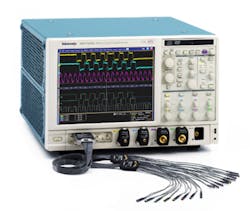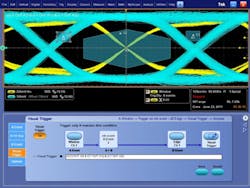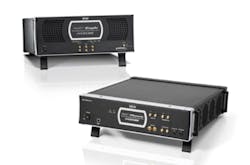From EDA to TDR, Tools Support High-Speed Analysis
For testing multigigabit-per-second serial buses and processor and memory interfaces, you can choose from a variety of instruments and software tools. The instruments have the bandwidth to handle next-generation serial interfaces, and they’re available with interface-specific software that can simplify characterization and validation tasks. And even before your prototypes get to the bench, you can make use of design-automation software that provides insight into how your design will perform. Specific instruments for the task include logic analyzers, protocol analyzers, bit-error-rate testers (BERTs), phase-noise testers, spectrum analyzers, vector network analyzers, and, of course, oscilloscopes.
Shamree Howard, high-speed digital marketing program manager at Agilent Technologies, said Agilent’s offerings extend from EDA software to a time-domain-reflectometry (TDR) network analyzer option for cable test (Figure 1). The EDA tools, she said, “…provide views into the time and frequency domains, revealing the underlying problems and ensuring compliant designs.” Agilent also offers the PNA-X PLTS (physical-layer test system) software package, which, Howard said, “…has become an industry standard for calibration, measurement, and analysis of linear passive interconnects such as cables, connectors, backplanes, and PCBs.”
Courtesy of Agilent Technologies
Specific instruments that Agilent offers for serial-bus test include Infiniium 90000 Q-Series Oscilloscopes, which support transmitter and receiver testing from 20 GHz to 63 GHz. A high-end member of this family, said Howard, “… can recover clocks beyond 56 Gb/s, meaning it is ideal for 28-Gb/s and 32-Gb/s testing. By using the 90000 Q-Series, you will see a closer depiction of your signal than with any other real-time oscilloscope, thanks to its industry-leading noise floor, jitter measurement floor, and high bandwidth.”
Another oscilloscope suited to bus test, Howard said, is the 86100 Infiniium DCA Wideband Sampling Oscilloscope, which “…offers high accuracy and repeatability with ease of use to simplify characterizing signals from 50 MHz to 80 GHz. Digital designers can combine the mainframe and modules into four key instruments with industry-leading signal-integrity performance.”
Analyzers and BERTs
Agilent also supplies logic analyzers, protocol analyzers and exercisers, and BERTs. Howard said a logic analyzer helps you minimize project risk by providing the most reliable, accurate measurements and an extensive view of system behavior. “AXIe-based logic analyzers,” she said, “provide the highest performance available with a state acquisition rate up to 4 Gb/s, 136 channels per module, and memory depth up to 200M.”
Agilent’s J-BERT N4903B high-performance serial BERT, Howard said, operates up to 7 Gb/s and 12.5 Gb/s. It provides complete jitter tolerance test for embedded and forward clocked devices and is suitable for R&D and validation teams characterizing and stressing chips and transceiver modules that have serial I/O ports up to 7 Gb/s, 12.5Gb/s, or optionally 14.2 Gb/s. “It can characterize a receiver’s jitter tolerance and is designed to prove compliance to today’s most popular serial bus standards,” Howard said. “Our product line offers BERT solutions for characterizing and compliance testing of the physical layer of receivers used in gigabit serial buses.”
Agilent protocol-analyzer and exerciser products, Howard said, are effective for debugging, validating, and optimizing semiconductors, software, and systems that use serial protocol standards for computer, storage, display, mobile, and embedded-system applications. Finally, Howard said, the ENA OptionTDR is application software embedded in an ENA network analyzer that provides a one-box solution for high-speed serial interconnect analysis. “For signal-integrity design and verification, it brings three breakthroughs,” she said, enumerating “simple and intuitive operation, fast and accurate measurements, and ESD robustness.”
Serial Standards Support
Chris Loberg, senior technical marketing manager at Tektronix, said his company has a long history of supporting the serial standards industry with a goal of improving test productivity. Tektronix, he said, offers serial bus designers an array of physical- and protocol-layer test instruments and software tools.
For example, he said, “For PHY-layer transmitter testing, Tektronix provides the DSA70000 Series Realtime Oscilloscope and the DSA8300 Series Sampling Oscilloscope. Both instruments have strong signal fidelity with low-noise performance and accurate trigger and time-base capabilities.” Engineers use these oscilloscopes, he said, for transmitter compliance test and/or debugging efforts.
He noted that the DSA70000 Series Oscilloscopes also support protocol-layer testing because the scopes contain serial bus decoding, capture, and display capabilities. But for advanced protocol-layer tests, he said, the company’s TLA7SAxx Protocol/Logic Analyzer provides in-depth support for critical PCI Express protocol capture and debug. In addition, he noted, the TPI4000 family of protocol analyzers supports many of today’s common serial bus standards.
For PHY-layer cable testing, Loberg said, Tektronix offers the DSA8300 Series Sampling Oscilloscope, which includes high-speed TDR sampling modules for characterization of cables and connectors as defined by the standards-specific test requirements. IConnect analysis software, he said, complements this TDR capture capability; it provides S-parameter results for de-embedding frequency effects for more accurate measurements.
Tektronix also supports PHY-layer receiver testing, for which it offers a variety of choices for stressed pattern generation. “The BERTScope Series provides pattern generation and BER-based analysis in a single instrument,” Loberg said. “With support up to 28.6Gb/s, the BERTScope can be equipped with optional DPP and CR modules for more accurate, standards-specific receiver test requirements. BERTScopes also can be configured with optional automation software for stressed signal calibration and testing.”
Another receiver test option from Tektronix, Loberg said, is the AWG7000 Series Arbitrary Waveform Generators (Arbs). Using direct digital synthesis, the Arb can accommodate specific signal stress requirements that need careful modeling of the stressed signal. He added that the Arb capabilities are complemented by optional error-detection software available on the DSA70000 Series Oscilloscopes to deliver effective BER measurement results.
Loberg said that a goal for Tektronix in serving serial bus testing applications is to provide a seamless integration of compliance and debug environments. “These are not two separate applications—for example, it’s not just black-box testing for pass/fail compliance. Tektronix is trying to support the inevitable failures that occur during compliance testing efforts with tools and analysis capability that do both.”
He provided some examples of instruments and technologies that Tektronix offers. For example, he said, the MSO70000 Series Mixed-Signal Oscilloscope (Figure 2) offers 16 logic channels (at 2.5 GHz/channel) along with four traditional analog channels (up to 20 GHz) for multichannel, high-speed acquisition of signals such as those found with DDR3/4 devices. The MSO70000 supports the debugging of setup and hold issues on high-speed systems or the evaluation of crosstalk/skew with adjacent control bus traffic.
Courtesy of Tektronix
In addition, Loberg said, Visual Trigger (Figure 3), which he called the industry’s only area-based trigger system with dynamic configuration capability, makes verification of failed pattern testing simple and efficient. And finally, he said, DPOJET is the core timing analysis engine on every DSA70000 Series Oscilloscope. Built in with early serial bus standards support, DPOJET also provides root-cause analysis of timing issues when standards tests fail. Seamlessly tied to compliance testing, engineers can launch DPOJET and rerun failed measurement data.
Courtesy of Tektronix
Physical Phenomena Beyond 20 Gb/s
Hiroshi Goto, business development manager at Anritsu, outlined issues attendant to serial bus test. “For interconnect technologies using high-speed signals of 20 Gb/s or higher, closer attention must be given to physical phenomena that can impact signal integrity,” he said. “Measurement solutions are available for evaluating jitter, ISI, and crosstalk and properly employing the necessary countermeasures to ensure signal integrity. It is important to take into account the signal-integrity reduction for both the transmitter circuit and the receiver circuit to ensure the quality of the output signal and receiver tolerance.” He added that securing the quality of the output signal and the receiver tolerance can be achieved by measuring jitter, ISI, and crosstalk to ensure overall backplane and high-speed interface performance.
Goto said that for signal-integrity test, Anritsu offers the MP1800A Signal Quality Analyzer (SQA), a modular BERT with three built-in modules: a pulse pattern generator (PPG) that supports output of high-quality, high-amplitude signals; an error detector (ED) with high input sensitivity supporting signal analysis, such as bathtub and eye diagram measurements; and a jitter modulation source for generating various types of jitter, such as SJ/RJ/BUJ/SSC, and supporting jitter tolerance tests.
The new 28/32-Gb/s multichannel PPG and ED modules, Goto said, support signal-integrity tests on PCBs with high-speed interconnects up to 32.1 Gb/s. When configured with the new modules, he said, the MP1800A can conduct BER measurements for device R&D and simultaneously measure crosstalk between multiple channels.
Adding synthesizer and jitter modules creates a test environment without the need for an external signal generator. Moreover, signal-integrity tests at up to 28.1 Gbit/s are supported by linked operation with the MP1825B 4-Tap Emphasis capability, which provides programmable pre-emphasis—an effective technique for opening closed eyes on high-speed backplanes and interconnects.
Scopes, Analyzers, and Software
Teledyne LeCroy offers a variety of products for serial bus test, including oscilloscopes, serial data analysis software, signal integrity network analyzers, compliance software, protocol-enabled receiver and transmitter tolerance testers, and PCIe protocol analyzers.
Ken Johnson, director of marketing for high-bandwidth oscilloscopes, said the company’s high-performance real-time digital storage oscilloscopes are used for a variety of tasks. “They can isolate and debug circuit issues and characterize signal-integrity effects such as vertical noise, crosstalk, and jitter,” he said. “An additional testing function is to verify that devices and systems meet compliance requirements of serial data communications standards such as PCIe Gen3 and Gen4. Users rely on the capability of our oscilloscopes to trigger on serial data patterns and faithfully reproduce the input signal to make the most accurate measurements possible.”
He cited the following scopes as serving high-speed serial applications:
- the 1.5-GHz to 6-GHz, 40-GS/s, four-channel WavePro 7 Zi-A.
- the 4-GHz to 45-GHz, 120-GS/s, four-channel WaveMaster 8 Zi-A.
- the 13-GHz to 45-GHz, 120-GS/s 9 Zi-A with up to 80 channels.
- the 25-GHz to 65-GHz, 160-GS/s 10 Zi with up to 80 channels.
Dr. Alan Blankman, product marketing manager for signal integrity including SDAIII-CompleteLinQ and SPARQ products, said, “Our serial data analysis software platform (SDAIII-CompleteLinQ) is used on our real-time oscilloscopes to make eye, jitter, and noise and crosstalk measurements on multilane or single-lane serial data systems. Measurements are used to identify and characterize the signal integrity characteristics and problems in high-speed serial data transmission systems.”
The software, he added, integrates additional signal-integrity toolkits—including EyeDoctorII and VirtualProbe—that equalize a signal or de-embed the fixture and channels from live measurements. The SDAIII-CompleteLinQ family is available on WavePro 7 Zi-A and WaveMaster 8 Zi-A, 9 Zi-A, and 10 Zi Series Oscilloscopes.
Blankman also said the company’s SPARQ Series Signal Integrity Network Analyzers—designed specifically for signal-integrity applications—can measure the S-parameters of the interconnects, backplanes, cables, and connectors used in the transmission of high-speed serial data signals. Signal-integrity engineers, he said, can use SPARQ measurements in simulations to validate and refine models and verify device performance. SPARQ series products include two-, four-, eight-, and 12-port 30-GHz models and two- and four-port 40-GHz models.
David Li, product marketing manager for PeRT3 at Teledyne LeCroy, described the PeRT3 protocol-enabled receiver and transmitter tolerance testers (Figure 4) as filling the space between PHY-layer test and protocol test. The system includes two platforms, the PeRT Eagle (6 Gb/s) and PeRT Phoenix (8 Gb/s). “The PeRT3 is essentially a protocol-enabled BERT, which is highly advantageous since it can communicate with the DUT in protocol language and transmit commands and receive acknowledgements from the DUT to enable closed-loop transmitter and receiver testing,” he said.
Courtesy of Teledyne LeCroy
He cited USB 3.0 testing as an example in which a DUT must be put in a loop-back mode. Another example, he said, is PCIe Gen3 in which the transmitter and receiver exchange commands and acknowledgements to dynamically set the equalization parameters in the receiver for a given transmission channel (a process called dynamic equalization).
Teledyne LeCroy also offers its QualiPHY compliance testing software platform, which performs transmitter and receiver testing of attached DUTs by analyzing signals acquired by a connected oscilloscope. Users run QualiPHY software to verify compliance to a range of high-speed serial data standards including USB 3.0, PCIe Gen3, and DDR3. The QualiPHY software controls both the oscilloscope and PeRT3 for complete closed-loop transmitter and receiver testing capabilities.
John Wiedemeier, product marketing manager for PCIe protocol analysis, commented on the company’s PCIe protocol analyzers, including the Summit Series. The series includes PCIe 3.0 protocol analyzers that ensure 1x to 16x lane protocol correctness and analyze performance, PCIe 3.0 protocol exercisers that enable 1x to 16x lane protocol functional and corner case testing, and a PCIe 2.0 protocol test card that supports PCIe 2.0 protocol compliance. In addition, SimPASS PE software supports presilicon analysis for EDA tools.
Frequency Domain
Serial bus test brings to mind the image of the eye diagram—a time-domain representation of the serial-bus signal. However, as a spokesperson for Rohde & Schwarz pointed out, “Timing jitter of the clock in the time domain generates phase noise in the frequency domain. Therefore, a phase-noise test system can measure jitter more accurately than oscilloscopes, especially in the gigahertz range due to very good internal oscillators and modern cross-correlation techniques in combination with higher resolution of A/D converters.”
To handle such tests, Rohde & Schwarz offers the R&S FSUP, a flexible three-in-one instrument that combines a signal-source analyzer, a phase-noise tester, and a spectrum analyzer. And for PHY-layer differential transmission link test from broadband to 110 GHz, the company provides the R&S ZVA, ZNB, ZNC, ZVB, and ZVL Vector Network Analyzers. The spokesperson said the VNAs are highly configurable and offer “best-in-class dynamic range” to support channel characterization.
Signal Access
Of course, instrumentation won’t be of much help if you can’t connect to the DUT. For signal access, Tektronix provides an array of standards-specific fixturing and probing for calibrated signal test points, Loberg said, adding that fixtures are available with S-parameter models to enable the de-embedding of their effects on critical signal-integrity tests. For probing systems, Tektronix offers the P7500/7600 Series Tri-Mode Probes, which eliminate the need for separate probes when accessing test points requiring both differential and single-ended DUT connections. The P7500/7600 Series supports up to 30-GHz in bandwidth and comes with a variety of connectivity options.
Howard said that Agilent offers “…an innovative selection of probes engineered for superior signal access and measurement accuracy, whether you’re looking for simple passive probes, the high bandwidth and low loading of an active probe, or specialty probes for current or high voltage.” Agilent’s offerings include BGA probes, flying lead probes, soft-touch connectorless probes, ZIF probes, and flex-wing BGA probes that give you a quick connection to either a logic analyzer or an oscilloscope. He added that Agilent also offers custom probing solutions for special needs, and the company can recommend third-party solutions as well.
Teledyne LeCroy provides the WaveLink Series of high-impedance differential probes designed for signal acquisition up to 25 GHz. A variety of tips is available with support for solder-in, browser, square-pin, and SMA/SMP cabled tip/lead connections. Users can de-embed the probes from the measurement and relocate the measurement position with the VirtualProbe Signal Integrity Toolkit software add-on. For protocol-analyzer products, the company offers PCIe adapters, interposers, and multilead and mid-bus probing products.
In addition to instruments, software, and probes, vendors have expertise to help with serial bus designs. As Howard at Agilent put it, “Agilent’s solution set for high-speed digital test is a combination of instrumentation and broad expertise built on our ongoing involvement with industry experts.”
Employee participation in standards compliance workshops and conferences as technical leads and as members of the boards of directors of standards bodies, he said, helps Agilent provide cutting-edge technology ahead of the curve. He concluded, “We see the next generation of digital design challenges firsthand when creating our products and working with industry engineers. By providing cutting-edge technology and sharing our latest experiences, we can help engineers anticipate their next challenges and accelerate their ability to create products to be proud of.”
Exclusive Online Information
Visit www.evaluationengineering.com for exclusive online content that complements this report on high-speed serial bus test. You’ll find more information on pre-emphasis and signal-integrity challenges as well as details on vendors’ instruments and software. And you’ll find links to additional resources.




